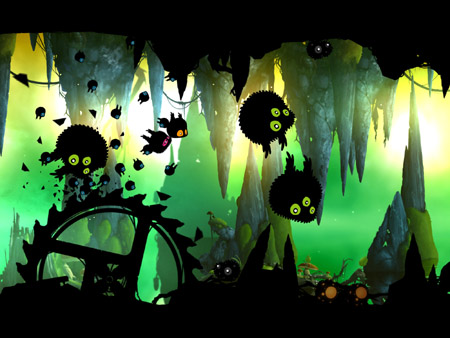According to Johannes Vuorinen from Frogmind the studio behind Badland you post a gameplay trailer.
Long before Badland hit the App Store, Vuorinen revealed at his talk at GDC Europe in Cologne, Frogmind worked on a specially tailored demo level to utilise in a trailer, showing off all the game's features in just a few short minutes.
Not long after the video was published on YouTube, it had amassed 40,000 views and gained the attention of the press and publishers alike.
Oh and rather Apple liked it too.
Relationships
"Publishers kept telling us they had an Apple contact and a relationship with websites, and we thought 'well, we have a contact at Apple now too, we don't need you'," joked Vuorinen during his talk.
Indeed, it's Vuorinen's belief that the old line that developers need to spend thousands of dollars (if not more) on marketing both before and after a game's launch is now nonsense.
He has a "strong belief that good games will sell well without massive marketing budget."
"We did some indie marketing, but if you have a good game, you don't need to spend a lot of money," he added.
So what did Frogmind do? It started talking to the press and public alike before it had a game to announce, launching a holding page describing the studio's background accompanied by a clock counting down to the reveal of its first title.
Frogmind then emailed the likes of Gamasutra and Pocket Gamer with a link to the site, who, in turn, picked up the story.
Small stories
"It's always interesting how small indie studios are born," said Vuorinen. "Developers should share their stories, because it can be really interesting, even if they don't actually have any game to show."
Indeed, for Frogmind, story was very important. The studio was founded by people who had worked on recognised games at respected studios, which made the firm the perfect target for press coverage.

Garnering the same level of attention for a game by a studio without any kind of history whatsoever would arguably be far more difficult.
Nevertheless, once Badland was unveiled, Frogmind launched a development blog, tracking the progess of the game out in the open.
"It's not a good idea to hide in your garage working on the game - announce your game early," he urged. "You might get feedback and be able to react to this feedback with the game."
Further gameplay trailers followed, and the studio also entered every development competition going. As a result, when the studio won some of them, it was able to dub Badland 'award winning' before it even launched.
But wasn't launching a paid game in the current free-to-play environment hard? According to Vuorinen, quite the opposite. Making successful free-to-play releases is difficult, he contend.
"Designing a free-to-play game without compromise is hard," he concluded.
"It's just not easy to do. However, launching a paid game means you have to do a lot of other things. Paid means the game has to look interesting, it has to have a great icon, and you have to have great user reviews."






















